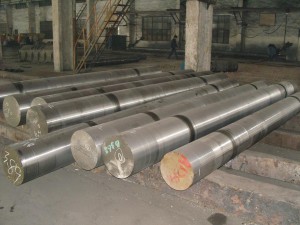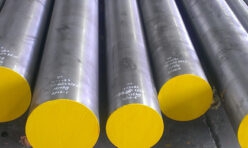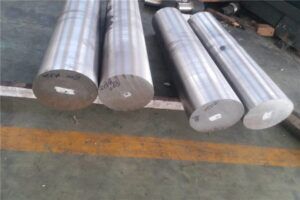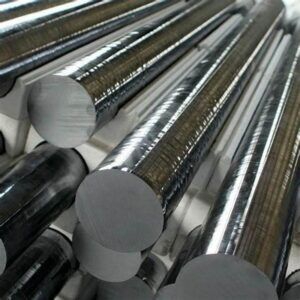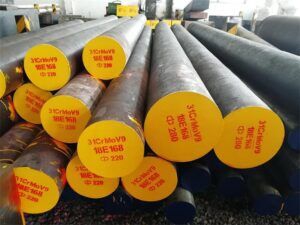Quenched and Tempered 35NCD16 835M30 EN30B DIN 1.6773 36CrNiMo16 Steel
35NCD16 Quenched and Tempered 835M30 EN30B DIN1.6773 36CrNiMo16 Steel
35NCD16 Introduce
35NCD16 is a low alloy steel which combines high strength and hardenability with good dimensional stability, making it an excellent alloy for large section mechanical parts or tooling of complex shapes subject to high stressses. In addition to aerospace structural applications, it is also suitable for mould for manufacturing plastic materials and bolster for drop stamps. 35NCD16 is supplied in either the Normalised & Tempered or Hardened & Tempered condition, but can also be heat treated with an additional sub-zero stage for increased strength and hardness.
1 35NCD16 Applications:
The applications of 36CrNiMo16 Steel are numerous and includes the following:
- In Engineering: ultra high tensile applications, shafts, gears, bolts, spline shafts, crusher shafts, eccentric shafts, hard wearing bushes and high impact pistons
- In mining: rock drill, knock off bits, mill hammers, cyclone plates, high tensile mechanical and thermal shock applications
- In Tooling: plastic extrusion dies, die bolster rings and punches
Back to Top
2 Quality Standard:
DIN EN 10083 Steel for quenching and tempering Part 3 Technical delivery conditions for alloy steels
Back to Top
3 All Grades Comparison:
Back to Top
4 35NCD16 Chemical Composition(%):
| C | Mn | Si | P | S | Cr | Ni | Mo |
|---|---|---|---|---|---|---|---|
| 0.32-0.39 | 0.30-0.60 | 0.40 max | 0.030 max | 0.025 max | 1.60-2.00 | 3.60-4.10 | 0.25-0.45 |
Back to Top
5 Mechanical Properties(In Nomalized Condition):
| Dia/Thickness(mm) | Tensile Strength Rm (Mpa) | Yield Strength R2 (Mpa) | Elongation (longitudinal direction) Al (%) | Elongation (transverse direction) At (%) | Impact properties (KV J) (longitudinal) | Impact properties (KV J) (transverse) |
|---|---|---|---|---|---|---|
| 160 max | 1000 min | 800 min | 11 min | 8 min | 45 min | 22 min |
| 160-330 | 1000 min | 800 min | 11 min | 8 min | 45 min | 22 min |
| 330-660 | 1000 min | 800 min | 11 min | 8 min | 45 min | 22 min |
Back to Top
6 Characteristics:
- This is a very expensive steel specification not just because of the high alloying elements but also the refining methods utilised to keep the hydrogen (H) content of the steel to less than two parts per million, (H = ≤ 2PPM). It is more costly than other BS970 specifications
- This is 1500MPa minimum tensile steel, air hardening in sections up to 65mm diameter.
Specially recommended for intricately shaped parts where an air hardening steel is preferred - This material can be case hardened, can be carburised and induction hardened or shorterised (flame hardened).
Back to Top
7 Heat Treatment:
Heat treatment temperatures, including rate of heating, cooling and soaking times will vary due to factors such as the shape and size of each 36CrNiMo16 Steel component. Other considerations during the heat treatment process include the type of furnace, quenching medium and work piece transfer facilities. Please consult your heat treatment provider for full guidance on heat treatment of this 4.25% nickel alloy steel.
| Forging | Heat the steel carefully to the forging temperature of 1000-1100°C, soak well. After forging, cool slowly in a furnace to 100°C maximum and anneal immediately. |
| Annealing | To obtain the softest condition heat carefully to 630-650°C. Soak for a minimum of 2 hours, then cool in the furnace or in air. It is advisable to repeat this treatment to obtain the best machining characteristics. |
| Stress Relieving | Where the machining operations have been severe, we recommend stress relieving 36CrNiMo16 Steel before finish machining and hardening. Heat carefully to 630-650°C then cool in the furnace or in still air. |
| Hardening | Heat uniformly to 810-830°C and when thoroughly soaked at this temperature cool in air or quench in oil according to mass. Hardening from neutral salt baths will help to prevent scaling or decarburisation and is strongly recommended. Pre heat at 300-400°C, raise to the hardening temperature of 810-830°C, quench into salt standing at 300-320°C. Withdraw and cool in air. Alternatively, tools may be vacuum hardened. If desired, hardened and tempered tools can be cyanide hardened to give a shallow carburised case to die surfaces with increased hardness values up to Rockwell C56-60. Temper as soon as tools are hand-warm. |
| Tempering | Re heat to the relevant tempering temperature. Soak for at least 2 hours per 25mm of ruling section. Withdraw from the furnace and cool in still air. Tempering between 275-450°C is not advised as tempering within this range will reduce the impact value. | |||
| Tempering °C | 150 | 250 | 350 | 450 |
| HRc | 49 | 47 | 44 | 38 |
Back to Top
8 Mill´s test certificate:
EN 10204/3.1 with all relevant data reg. chem. composition, mech. properties and results of testing.
Back to Top

